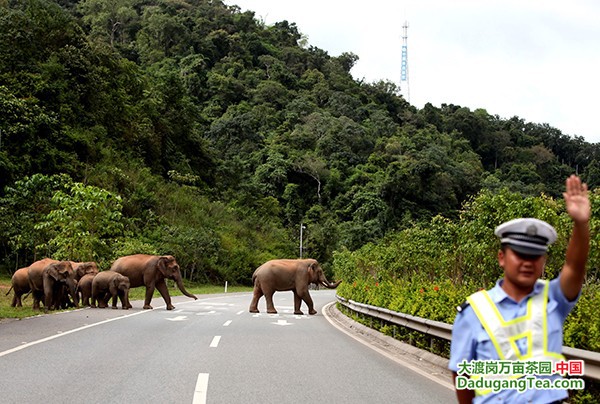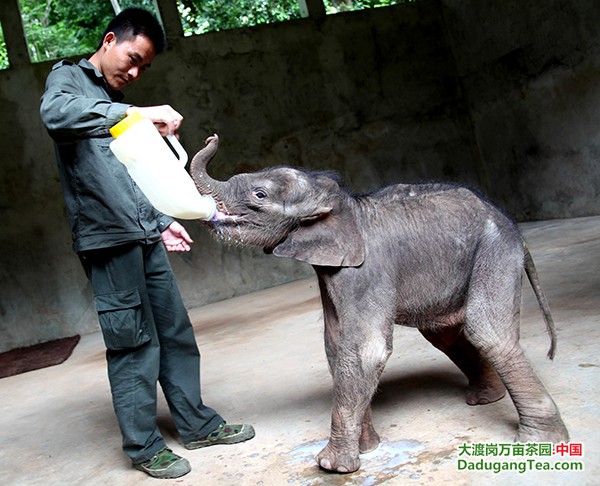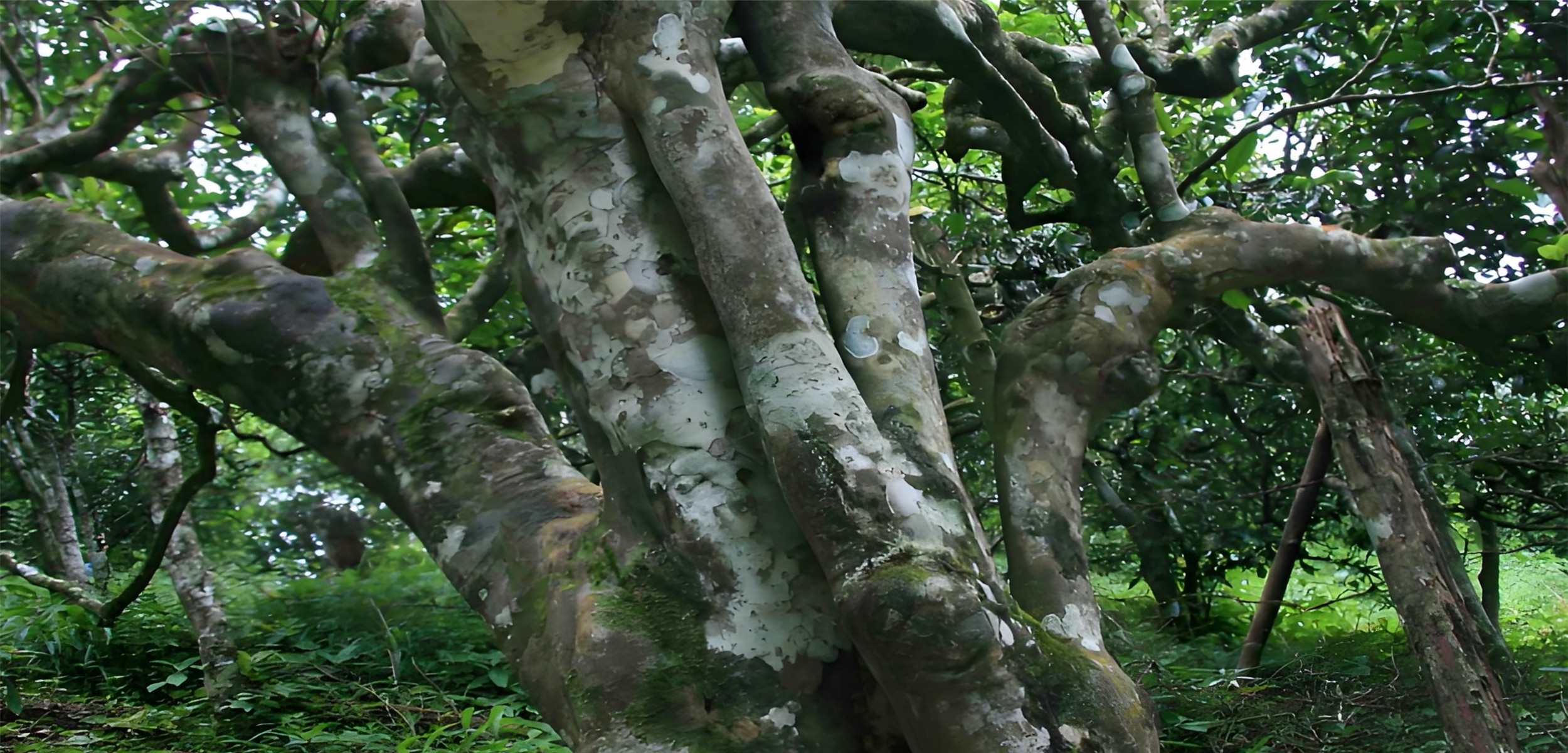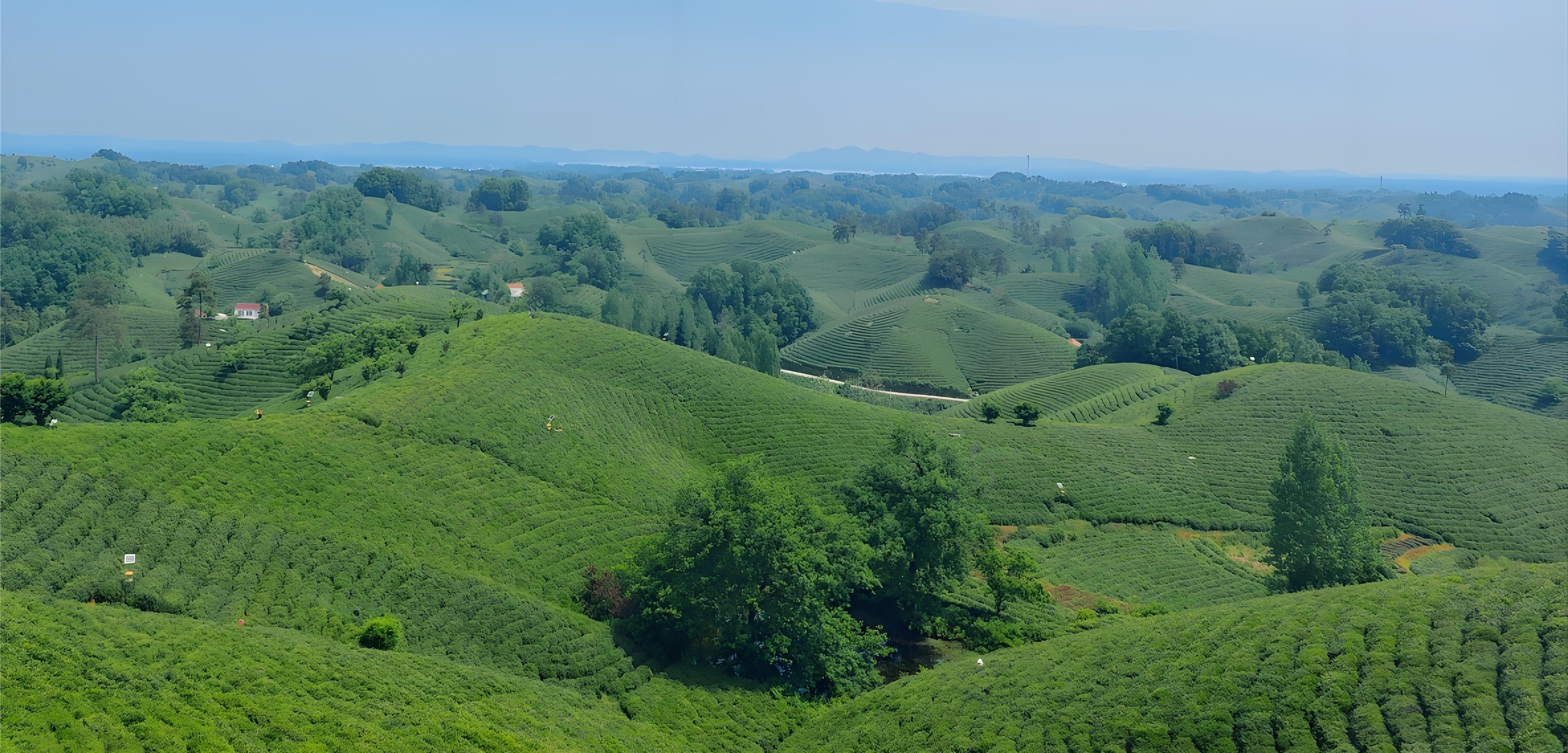【西双版纳】西双版纳抓实生态环境保护—— 人象共生 和谐家园 [Xishuangbanna] Xishuangbanna takes solid measures to protect the ecological environment - promoting coexistence between humans and elephants, building a har
素有“森林生态博物馆”等美誉的西双版纳,拥有地球北回归线上仅存的热带雨林,保护着756种野生动物,占全国的四分之一,其中被列为国家重点保护的珍稀动物就达109种,境内不仅保存着我国最大的野生亚洲象种群,还分布着印度野牛、印支虎、鼷鹿等珍稀濒危野生动物,是联合国“世界生物多样性保护圈”成员。
目前,西双版纳傣族自治州的自然保护区实际面积从原来的360万亩增加到622.8万亩,制定保护生态的条例、法规、规章20多部,2008年投资约700万元在野象谷内建立了国内第一个亚洲象繁育基地,全州71%以上生态良好的乡镇均有野生亚洲象活动。2017年9月,西双版纳州荣获全国首批、也是全省唯一的“国家生态文明建设示范州”称号。

交警护航野象横穿高速路

被救助后成为网红的小象“羊妞”
倾心救助 大爱无疆
除了通过制度性的立法保护和打击违法犯罪来实现生态环境的保护外,对于身处困境中的亚洲象等野生动物实施救助,也同样是西双版纳实施保护的重要手段之一。
2005年7月7日,一头年仅3岁的受伤小野象在野象谷森林中被发现后,西双版纳当地救助部门组织了上百人的队伍,冒着被野象群攻击的危险,成功地将这头受伤的野象运出森林。这也是中国境内第一起将受伤野象从象群中成功麻醉实施救助的案例。
西双版纳国家级自然保护内的野象谷,因野象活动频繁而得名。1996年正式建成开放至今,除了作为景区接待游客外,还建成了西双版纳最大的野生动物收容救护中心,承担起了救助受伤和受困野象及其它野生动物的社会责任,至今已收容救助1200余头(只)野生动物。
2007年“十一”黄金周期间,一场营救野象的行动在中老边境有序拉开。一头在中老边境地区活动的母象遭到公象攻击受伤,命垂一线,在勐腊县勐满镇南坪村附近被村民发现后,一支由公安民警、亚洲象专家和医护人员等组成的51人队伍,对其展开救助。
通过救护小组悉心照料,母象伤势渐趋好转。10月18日,救护组将其运到野象谷安置在救助中心内,并取名“平平”,寓意中老两国永远和平。
随后,在野象谷安家的“平平”再次出现严重感染,西双版纳州相关部门专门请来了昆明动物园的亚洲象专家和昆钢职工医院的医护人员,与当地的6名医护人员组成专家医疗组,于10月30日为这头重达2.7吨的亚洲象进行一次陆地上最大的“妇科”手术,治愈后的“平平”此后开始了快乐的生活。
2008年,国家投资约700万元在野象谷内建立了我国第一个亚洲象繁育基地,包含了象房栏舍、交配房、产房、检疫隔离室、医疗室、管理办公室等配套工程,旨在保护和拯救国内珍稀的野生亚洲象资源、保护生物多样性、维护自然生态平衡,提高我国亚洲象研究技术、促进西双版纳地区野生亚洲象资源的保护和发展。
2015年3月4日,西双版纳国家级自然保护区迎来了一群特殊的客人,英国的威廉王子。威廉王子一下飞机就赶往60公里外的西双版纳国家级自然保护区,到景洪市大渡岗乡勐满村与村民交流,随后来到位于野象谷内的中国野生亚洲象繁育基地,查看被救助后在繁育基地“安家”的野象,对中国的亚洲象保护工作给予了高度赞赏。
为有效保护亚洲象,近年来西双版纳森林警察先后开展了拯救亚洲象行动、南方二号行动等多次专项行动,严厉打击了各种非法猎捕、运输、销售野生动物等违法犯罪行为,目前已连续5年没有发生猎杀和伤害亚洲象的案例。西双版纳州检察机关通过发挥诉前检察建议及提起民事公益诉讼等职能,与林草部门共建生态修复、生物多样性保护试验林,达到办理一个案件、净化一片蓝天、修复一片生态的效果。两级人民法院通过对破坏森林资源违法犯罪保持严厉打击的高压态势,破坏森林资源行为得到了有效遏制。据统计,2021年1月至5月,西双版纳全州破坏森林资源违法犯罪案件同比下降了76.6%。
数据显示:长期在西双版纳生活的野生亚洲象数量,已从80年代的170余头发展至目前的近300头左右。值得庆幸的是,2005年救助回来的野生亚洲象“然然”,于2019年9月21日凌晨4时35分生下了一头健康的象宝宝。同时“然然”也成为了获救助的野象中,第一头通过人工干预怀孕当妈妈的亚洲象。
生态建设 久久为功
2015年至2017年,勐海县布朗山乡村民岩某擅自到西双版纳布龙州级自然保护区内开垦土地并种上了茶树,其行为使森林资源遭到严重破坏,损害了社会公共利益,最后被森林公安机关查处后,经检察机关提起民事公益诉讼、人民法院依法调解,岩某第一时间组织家人按调解协议要求对被侵占的林地完成清理,并表态今后一定要积极当好森林保护的“宣传员”。这只是西双版纳州严守生态红线,以“零容忍”的态度惩治破坏森林资源犯罪违法行为,保护生态环境的一个缩影。
近年来,西双版纳州把“建设生态州”列入《西双版纳傣族自治州自治条例》,先后制定20多部保护生态的条例、法规、规章,用法制、制度保护生态,推动形成全州主体功能区管控机制,将全州绝大部分区域列为限制开发的国家级重点功能区,各类自然保护区被列为禁止开发区,严守生态环境安全红线,严厉打击毁林开垦、蚕食热带雨林等破坏生态环境的违法行为。
与此同时,创新落实保护机制,在全省率先建立森林目标管理责任制,在全国开创性建立野生动物公众责任保险,生态环境保护在全州各级领导班子和领导干部考核指标体系中的权重达21.5%,对重大环境责任实行“一票否决”,保护生态环境从“软指标”变成了“硬任务”。通过持续实施天然林保护、退耕还林、水土流失治理等重大生态工程和自然保护区建设工程,不仅使辖区内的生态环境得到了保护,而且还创新保护机制,先后与老挝和缅甸掸邦东部第四特区携手创建跨境自然保护区,实现了边境地区生态环境的跨境保护。
2018年1月27日凌晨4时32分,一头野生亚洲象来到中老边境的岔河边境检查站,大摇大摆跨过边防执勤跨栏“冲卡”出境。92分钟后,这头“跨国游”野象又原路经边检通道返回中国境内。这是野生亚洲象首次经过这个位于中老跨境保护区域的边境检查站出入境,并被边检站的监控完整地拍摄了下来。“野生亚洲象从人来人往的检查站通过,说明跨境生态保护见成效了。”西双版纳自然保护区管理局负责人说,过去边境地区的人象冲突时有发生,这群活跃在边境地区的“国际野象”很怕人,一直以来都是从人迹罕至的森林或荒野出入境。
由5个子保护区组成的西双版纳国家级自然保护区,其中勐腊和尚勇两个子保护区与老挝接壤,边境线长108公里。早在十多年前,西双版纳国家级自然保护区就提出“中老生物多样性跨边境联合保护”构想。2009年底,随着中老双方划定第一片中老跨境联合保护区域——“中国西双版纳尚勇-老挝南塔南木哈生物多样性联合保护区域”,拉开了中老生物多样性跨边境联合保护序幕。
2010年,中老边境一线又新增3片联合保护区域。一条南起老挝南塔省南木哈国家级自然保护区,北至中国西双版纳勐腊子保护区,长约220公里,面积约300万亩的跨境联合保护区域形成。目前,中老跨境联合保护已上升为两国政府层面的合作,为边境地区的亚洲象及生物多样性保护筑牢了生态安全屏障,开创了中国生态保护的“跨境”先河。
“在2016年开展中老跨境保护区域野生动物资源调查时,不仅拍摄到野生亚洲象,还拍摄到了金钱豹、大灵猫、小灵猫、豺、熊等野生动物种类实体图像。”西双版纳自然保护区管理局负责人说,西双版纳及边境地区的生态保护成效也越来越显著。
创新思路 化解冲突
随着种群数量的不断增加,亚洲象的活动范围不断扩大,走出保护区觅食也成为必然。“保护区内的原始森林内很少生长亚洲象喜食的粽叶芦、蔗茅、构树、对叶榕及竹子等植物。”40多年来一直从事亚洲象保护和研究的西双版纳保护区科研所工程师董永华介绍,这些植物一般生长在低凹的河谷地带以及森林不太茂密的次生林里面。
“25年前,中国的亚洲象只在西双版纳和临沧境内有分布,几乎不到普洱市区域活动。”董永华说,现在除了西双版纳外,上述的几个地方、甚至勐海县都扩大成为了亚洲象的栖息地。如今,亚洲象种群不断增加,这与多年来的持续保护和村寨外迁有紧密关系。森林越来越茂密使得亚洲象必须走出更外围的次生林、甚至农田觅食。
为了解决亚洲象到农田觅食等问题,西双版纳州一直在多方探索构建人象和谐共生家园的新途径。
位于保护区边缘的景洪市大渡岗乡关坪村委会香烟箐村小组地处亚洲象活动频繁区域,生产受限,加上受地质灾害影响,村民生活较为艰难。村支书冯广林介绍,2014年,景洪市投入540余万元资金,对这个23户人家的村寨实施易地扶贫搬迁。2017年,又通过亚洲象保护项目为村寨修建了一段800米长的防护栏,有效缓解亚洲象进入村寨导致人象冲突的安全隐患。同时还将村民原先耕种的土地租用做食物源基地建设,并将村民就地安置到野象谷景区就业以及引导村民发展农家乐等方式增收致富。
如今的香烟箐,村民人均纯收入高居大渡岗乡各村寨,成了名副其实的中国人象和谐共处第一村。
同时,随着亚洲象检测预警平台的建立,将人象和谐共生的生态系统建设又向前推进了一步。6月4日一早,村民刀文忠在景洪市景讷乡曼散村曼窝村民小组等待着保险理赔员来勘查定损,他在亚洲象监测员的指导下,正在手机上安装西双版纳亚洲象预警平台App。
“昨晚有大象到农田里找东西吃,把我家的秧苗踩坏了。”刀文忠说,近几年来只要大象出现在村寨附近,村民们都是通过广播和手机微信接收预警信息,从而避免和野象发生冲突。“现在安装这个亚洲象预警平台App,一打开就能看到大象在什么位置,能及时避让。你看,现在象群距离我们大约2公里,一共有10头……”亚洲象监测员向志杰拿着手机说。
西双版纳自然保护区研究所所长郭贤明介绍,随着野生亚洲象种群不断向外扩散,频繁进入人类生产生活区域活动,导致人象活动空间重叠。为有效缓解人象冲突,2018年西双版纳州筹集了280万元资金,在勐海县率先建立了亚洲象监测预警中心,并在此基础上不断完善亚洲象监测预警体系建设,加大无人机、视频监控、红外相机、人员跟踪监测的密度、深度和广度,还自主研发了可以记录监测信息,实现区域内亚洲象监测信息的远程接收、实时传输。当地政府通过手机App、微信平台等实时发布亚洲象预警信息,强化设卡警戒工作,在亚洲象活动区域或地段,及时安放警示牌,专人值守,避免群众冒险进入,确保过往人员和劳作群众的生命安全。
目前,监测预警平台用户量已达20余万人,公众号关注人数达4万余人,该平台的推广运用有效保障了当地群众的出行及生产劳作安全。
针对亚洲象造成的社会财产损失及人员伤亡问题,西双版纳州在全国率先创立了野生动物公众责任险,于2010年与中国太平洋财产保险股份有限公司签订保险服务协议,每年平均投入1471万元,通过积极探索运用商业保险方式,有效缓解了政府财力赔偿不足等问题。
“除了建立有效的预警机制和公众责任险保障机制外,对于一些频繁闯入农户家中‘肇事’的野象,我们也在积极探索解决途径。”勐海县林草局局长马杰说,为最大限度将管控区项目发挥人象物理隔离的功效,该局在勐海县亚洲象“肇事”较为频繁的勐阿镇南朗河村委会帕西玛区域,实施建设的勐海县亚洲象应急处置临时管控建设试点项目已经于去年11月30日投入使用。
马杰介绍,该项目面积365亩,建设防护栏长度2263.73米,除了保持原有的生态环境外,还种植了甘蔗、芭蕉、玉米、棕绿叶和象草等大象喜食植物。目前已成功将4头经常“肇事”的亚洲象引导进入该区域进行保护,如今勐海县已经连续半年没有亚洲象“肇事”的记录,保险公司每年同期的公众责任险赔付金也由之前的200余万元下降到了今年的3万元左右。
“除了以上措施,西双版纳多年来还一直进行食物源基地建设,增加亚洲象的食物来源探索。”西双版纳州林草局副局长刀建红介绍,经过分析对比,食物源基地可在一定程度上吸引亚洲象,减少其到村寨或农地中的活动时间和机率,对缓解人象矛盾冲突效果显著。
从20世纪90年代起,西双版纳先后在尚勇子保护区的南墩、冷山河区域,勐养子保护区的关坪、莲花塘区域、凉水箐区域和树林寨区域等地进行了食物源基地建设。据不完全统计,10年来在莲花塘和关坪两个区域为主的监测中,共监测到以亚洲象为主的野生动物在食物源基地内的活动数量超过了600头次,大大减轻了村寨的压力。
“人与亚洲象和谐共生,是生态环境保护中最为理想的一种状态。”刀建红说,多年来,西双版纳各相关部门一直为实现这一目标而不懈努力。
Xishuangbanna, known as the "Forest Ecological Museum," boasts the only remaining tropical rainforest on the Tropic of Cancer and protects 756 species of wildlife, accounting for a quarter of the country's total. Among them, 109 species are listed as national key protected rare animals. Not only does it preserve the largest population of wild Asian elephants in China, but it also has rare and endangered wildlife such as Indian bison, Indochinese tiger, and deer. It is a member of the United Nations' "World Biodiversity Conservation Circle".
At present, the actual area of the nature reserve in Xishuangbanna Dai Autonomous Prefecture has increased from 3.6 million mu to 6.228 million mu, and more than 20 regulations, laws, and rules have been formulated to protect the ecology. In 2008, an investment of about 7 million yuan was made to establish the first Asian elephant breeding base in China in the Wild Elephant Valley, and more than 71% of the ecologically good towns in the prefecture have wild Asian elephant activities. In September 2017, Xishuangbanna Prefecture was awarded the title of "National Ecological Civilization Construction Demonstration Prefecture" among the first batch in China and the only one in the province.
Traffic police escort wild elephants crossing highways
The little elephant "Yangniu" who became an internet celebrity after being rescued
Heart to heart rescue, boundless love
In addition to protecting the ecological environment through institutional legislation and cracking down on illegal activities, rescuing Asian elephants and other wildlife in difficult situations is also an important means of protection in Xishuangbanna.
On July 7, 2005, a 3-year-old injured wild elephant was discovered in the Wild Elephant Valley Forest. The local rescue department in Xishuangbanna organized a team of over a hundred people to risk being attacked by the wild elephant herd and successfully transport the injured wild elephant out of the forest. This is also the first case in China to successfully anesthetize and rescue injured wild elephants from a herd.
The Wild Elephant Valley in Xishuangbanna National Nature Reserve is named after the frequent activity of wild elephants. Since its official completion and opening in 1996, in addition to serving as a tourist attraction, Xishuangbanna has also built the largest wildlife shelter and rescue center, taking on the social responsibility of rescuing injured and trapped wild elephants and other wildlife. So far, it has sheltered and rescued more than 1200 wild animals.
During the 2007 National Day Golden Week, a rescue operation for wild elephants was launched in an orderly manner along the China Laos border. A female elephant operating in the border area between China and Laos was attacked and injured by a male elephant, and her life was on the brink of death. After being discovered by villagers near Nanping Village in Mengman Town, Mengla County, a team of 51 people including public security police, Asian elephant experts, and medical staff carried out rescue operations.
Through the careful care of the rescue team, the mother elephant's injuries gradually improved. On October 18th, the rescue team transported him to the Wild Elephant Valley and placed him in the rescue center, naming him "Pingping", symbolizing eternal peace between China and Laos.
Subsequently, the "Pingping" elephant in the Wild Elephant Valley was once again severely infected. The relevant departments of Xishuangbanna Prefecture specially invited Asian elephant experts from Kunming Zoo and medical staff from Kunming Iron and Steel Workers' Hospital to form an expert medical team with six local medical staff. On October 30th, the largest "gynecological" surgery on land was performed on this 2.7-ton Asian elephant. After being cured, "Pingping" began a happy life thereafter.
In 2008, the country invested about 7 million yuan to establish China's first Asian elephant breeding base in the Wild Elephant Valley, which includes supporting projects such as elephant houses, sheds, delivery rooms, quarantine and isolation rooms, medical rooms, and management offices. The aim is to protect and save rare wild Asian elephant resources in China, protect biodiversity, maintain natural ecological balance, improve research technology for Asian elephants in China, and promote the protection and development of wild Asian elephant resources in Xishuangbanna region.
On March 4, 2015, Xishuangbanna National Nature Reserve welcomed a special guest, Prince William of the United Kingdom. Prince William immediately rushed to the Xishuangbanna National Nature Reserve, 60 kilometers away, to communicate with villagers in Mengman Village, Dadugang Township, Jinghong City. He then visited the Chinese Wild Asian Elephant Breeding Base located in the Wild Elephant Valley to inspect the rescued wild elephants that had settled down in the breeding base. He highly praised China's efforts in protecting Asian elephants.
In order to effectively protect Asian elephants, in recent years, the Xishuangbanna Forest Police have carried out multiple special operations such as the Save Asian Elephants Operation and the Southern Second Operation, severely cracking down on various illegal activities such as hunting, transporting, and selling wild animals. Currently, there have been no cases of hunting or harming Asian elephants for five consecutive years. The procuratorial organs of Xishuangbanna Prefecture have jointly established ecological restoration and biodiversity protection experimental forests with forestry and grassland departments by utilizing pre litigation procuratorial suggestions and filing civil public interest lawsuits, achieving the effect of handling one case, purifying one blue sky, and restoring one ecology. The two-level people's courts have effectively curbed the destruction of forest resources by maintaining a high-pressure situation of cracking down on illegal and criminal activities that damage forest resources. According to statistics, from January to May 2021, the number of illegal and criminal cases of destroying forest resources in Xishuangbanna decreased by 76.6% year-on-year.
Data shows that the number of wild Asian elephants living in Xishuangbanna for a long time has increased from over 170 in the 1980s to nearly 300 currently. Fortunately, the wild Asian elephant "Ranran" rescued in 2005 gave birth to a healthy baby elephant at 4:35 am on September 21, 2019. At the same time, "Ranran" also became the first Asian elephant to become a mother through artificial intervention among the rescued wild elephants.
Long term achievements in ecological construction
From 2015 to 2017, Yan, a villager from Bulangshan Township, Menghai County, illegally cultivated land and planted tea trees in the Bulong Prefecture level Nature Reserve in Xishuangbanna. His behavior caused serious damage to forest resources and harmed social public interests. After being investigated by the forest public security organs, the procuratorial organs filed a civil public interest lawsuit and the people's court mediated in accordance with the law. Yan immediately organized his family to complete the clearance of the occupied forest land according to the mediation agreement and stated that he must actively become a "propagandist" for forest protection in the future. This is just a microcosm of Xishuangbanna Prefecture strictly adhering to the ecological red line, punishing criminal and illegal activities that damage forest resources with a "zero tolerance" attitude, and protecting the ecological environment.
In recent years, Xishuangbanna Prefecture has included "building an ecological prefecture" in the "Autonomous Regulations of Xishuangbanna Dai Autonomous Prefecture", and has successively formulated more than 20 regulations, laws, and rules to protect the ecology, using legal and institutional protection to promote the formation of a control mechanism for the main functional areas of the whole prefecture. The vast majority of the prefecture's areas have been listed as national key functional areas with restricted development, and various nature reserves have been listed as prohibited development areas. The ecological environment safety red line is strictly observed, and illegal activities that damage the ecological environment such as deforestation and encroachment on tropical rainforests are severely cracked down on.
At the same time, we will innovate and implement protection mechanisms, take the lead in establishing a forest target management responsibility system in the province, and establish a pioneering public liability insurance for wildlife nationwide. Ecological environment protection will have a weight of 21.5% in the assessment index system for leadership teams and cadres at all levels throughout the state, and major environmental responsibilities will be vetoed with one vote. Protecting the ecological environment has changed from a "soft indicator" to a "hard task". Through the continuous implementation of major ecological projects such as natural forest protection, returning farmland to forests, and soil erosion control, as well as the construction of nature reserves, not only has the ecological environment in the jurisdiction been protected, but also innovative protection mechanisms have been established. We have successively collaborated with Laos and the fourth special zone in eastern Shan State, Myanmar to create cross-border nature reserves, achieving cross-border protection of the ecological environment in border areas.
At 4:32 am on January 27, 2018, a wild Asian elephant arrived at the Chahe border checkpoint on the China Laos border and swaggered over the border guard hurdle to "charge" out of the country. 92 minutes later, this "cross-border" wild elephant returned to China via the border inspection channel. This is the first time that a wild Asian elephant has passed through this border checkpoint located in the China Laos cross-border protected area for entry and exit, and has been fully captured by the monitoring of the border checkpoint. The fact that wild Asian elephants pass through checkpoints where people come and go indicates that cross-border ecological protection has been effective, "said the person in charge of Xishuangbanna Nature Reserve Management Bureau. In the past, conflicts between humans and elephants occurred in border areas, and this group of" international wild elephants "active in border areas are very afraid of people. They have always entered and exited from forests or wilderness areas that are rarely visited by humans.
The Xishuangbanna National Nature Reserve consists of five sub reserves, with Mengla and Shangyong sub reserves bordering Laos with a border of 108 kilometers. More than a decade ago, Xishuangbanna National Nature Reserve proposed the concept of "cross-border joint protection of biodiversity between China and Laos". At the end of 2009, with the establishment of the first cross-border joint protection area between China and Laos - the "China Xishuangbanna Shangyong Laos Nantnammuha Biodiversity Joint Protection Area", the prelude to cross-border joint protection of biodiversity between China and Laos was opened.
In 2010, three new joint protection areas were added along the China Laos border. A cross-border joint protection area with a length of about 220 kilometers and an area of about 3 million acres is formed, starting from Nanmuha National Nature Reserve in Nanta Province, Laos and ending at Menglazi Nature Reserve in Xishuangbanna, China. At present, the joint cross-border protection between China and Laos has risen to the level of cooperation between the governments of the two countries, building an ecological security barrier for the protection of Asian elephants and biodiversity in border areas, and pioneering China's "cross-border" ecological protection.
In 2016, during the investigation of wildlife resources in the China Laos cross-border protected areas, not only were wild Asian elephants captured, but also physical images of wildlife species such as leopards, big spirit cats, small spirit cats, jackals, and bears were taken. The head of the Xishuangbanna Nature Reserve Management Bureau said that the ecological protection effect in Xishuangbanna and border areas has become increasingly significant.
Innovative ideas to resolve conflicts
With the continuous increase in population size, the range of activity of Asian elephants continues to expand, and it has become inevitable for them to leave protected areas for foraging. In the primitive forests within the protected area, there are few plants that Asian elephants like to eat, such as bamboo leaves, sugarcane grass, mulberry trees, Ficus microcarpa, and bamboo. Dong Yonghua, an engineer at the Xishuangbanna Protected Area Research Institute who has been engaged in Asian elephant protection and research for more than 40 years, introduced that these plants generally grow in low-lying river valleys and less dense secondary forests.
25 years ago, Asian elephants in China were only distributed in Xishuangbanna and Lincang, and hardly active in the Pu'er City area. Dong Yonghua said that now, in addition to Xishuangbanna, the above-mentioned places, and even Menghai County, have expanded into habitats for Asian elephants. Nowadays, the population of Asian elephants is constantly increasing, which is closely related to years of continuous protection and village migration. The increasingly dense forests require Asian elephants to venture beyond the peripheral secondary forests and even farmland to forage.
In order to solve the problem of Asian elephants foraging in farmland, Xishuangbanna Prefecture has been exploring new ways to build a harmonious coexistence home for humans and elephants.
The Guanping Village Committee of Dadugang Township, Jinghong City, located on the edge of the protected area, is situated in an area with frequent Asian elephant activity, where production is restricted. In addition, due to geological disasters, the villagers' lives are relatively difficult. The village party secretary Feng Guanglin introduced that in 2014, Jinghong City invested more than 5.4 million yuan to implement relocation for poverty alleviation in this 23 household village. In 2017, an 800 meter long protective fence was built for the village through the Asian Elephant Protection Project, effectively alleviating the safety hazards of human elephant conflicts caused by Asian elephants entering the village. At the same time, the land previously cultivated by the villagers will be leased for the construction of a food source base, and the villagers will be resettled in the Wild Elephant Valley scenic area for employment and guided to develop rural tourism to increase their income and become prosperous.
Today's Cianqing has the highest per capita net income among all villages in Dadugang Township, and has become the first village where Chinese people and elephants live in harmony.
At the same time, with the establishment of the Asian elephant detection and early warning platform, the construction of a harmonious ecosystem between humans and elephants has been further promoted. On the morning of June 4th, villager Dao Wenzhong was waiting for an insurance claims officer to investigate and determine the damage in the Manwo village group of Mansan Village, Jingna Township, Jinghong City. Under the guidance of an Asian elephant monitor, he was installing the Xishuangbanna Asian Elephant Early Warning Platform App on his mobile phone.
Last night, an elephant went to the farmland to look for food and trampled on my seedlings, "said Dao Wenzhong. In recent years, whenever an elephant appears near the village, villagers have received warning information through broadcasting and mobile WeChat to avoid conflicts with wild elephants. Now install this Asian elephant warning platform app, and as soon as you open it, you can see where the elephant is and avoid it in a timely manner. You see, the elephant herd is about 2 kilometers away from us now, with a total of 10 heads... "said Asian elephant monitor Xiang Zhijie with his phone.
Guo Xianming, director of the Xishuangbanna Nature Reserve Research Institute, introduced that with the continuous expansion of wild Asian elephant populations, they frequently enter human production and living areas, resulting in overlapping human elephant activity spaces. In order to effectively alleviate conflicts between humans and elephants, Xishuangbanna Prefecture raised 2.8 million yuan in 2018 to establish the Asian Elephant Monitoring and Early Warning Center in Menghai County. Based on this, the construction of the Asian Elephant Monitoring and Early Warning System has been continuously improved, increasing the density, depth, and breadth of unmanned aerial vehicles, video surveillance, infrared cameras, and personnel tracking and monitoring. It has also independently developed a system that can record monitoring information and achieve remote reception and real-time transmission of Asian elephant monitoring information in the region. The local government releases real-time warning information on Asian elephants through mobile apps, WeChat platforms, etc., strengthens the work of setting up checkpoints and surveillance, timely places warning signs in areas or locations where Asian elephants are active, and assigns dedicated personnel to guard them to prevent people from entering at risk and ensure the safety of passing personnel and laborers.
At present, the number of users of the monitoring and early warning platform has reached more than 200000, and the number of people concerned by the official account has reached more than 40000. The promotion and application of this platform has effectively guaranteed the travel and production safety of local people.
In response to the social property losses and casualties caused by Asian elephants, Xishuangbanna Prefecture took the lead in establishing public liability insurance for wildlife in the country. In 2010, it signed an insurance service agreement with China Pacific Property Insurance Co., Ltd., investing an average of 14.71 million yuan per year. By actively exploring the use of commercial insurance methods, it effectively alleviated the problem of insufficient government financial compensation.
In addition to establishing effective warning mechanisms and public liability insurance protection mechanisms, we are also actively exploring solutions for some wild elephants that frequently break into farmers' homes and cause accidents, "said Ma Jie, director of the Forestry and Grassland Bureau of Menghai County. In order to maximize the physical isolation effect of the control area project, the bureau implemented the construction of the Menghai County Asian Elephant Emergency Response Temporary Control Construction Pilot Project in the Pasima area of Nanlanghe Village Committee in Meng'a Town, Menghai County, where Asian elephants frequently cause accidents. The project was put into use on November 30 last year.
Ma Jie introduced that the project covers an area of 365 acres, with a length of 2263.73 meters for the construction of a protective fence. In addition to maintaining the original ecological environment, it also planted elephant feeding plants such as sugarcane, banana, corn, brown green leaves, and elephant grass. At present, four Asian elephants that frequently cause accidents have been successfully guided into the area for protection. Menghai County has not had any record of Asian elephants causing accidents for six consecutive months, and the annual public liability insurance payout of the insurance company has also decreased from more than 2 million yuan to about 30000 yuan this year.
In addition to the above measures, Xishuangbanna has been building food source bases for many years to increase the exploration of food sources for Asian elephants, "said Dao Jianhong, deputy director of the Xishuangbanna Forestry and Grassland Bureau. After analysis and comparison, food source bases can attract Asian elephants to a certain extent, reduce their activity time and probability in villages or farmland, and have a significant effect on alleviating conflicts between humans and elephants.
Since the 1990s, Xishuangbanna has successively constructed food source bases in the Nandun and Lengshan River areas of Shangyongzi Nature Reserve, as well as in the Guanping, Lianhuatang, Liangshuiqing, and Shulinzhai areas of Mengyangzi Nature Reserve. According to incomplete statistics, in the past 10 years, a total of over 600 wild animals, mainly Asian elephants, have been monitored in the Lianhuatang and Guanping areas within the food source base, greatly reducing the pressure on the village.
Harmonious coexistence between humans and Asian elephants is the most ideal state in ecological environment protection, "said Dao Jianhong. For many years, relevant departments in Xishuangbanna have been tirelessly striving to achieve this goal.





